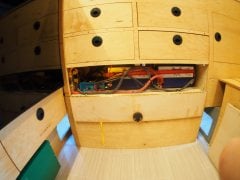Unless you are going to attach an inverter (12 VDC to 120 VAC), 6 gauge or even 8 gauge is fine - but see note below on charging.
The two main criteria for picking wire gauge are current capacity and voltage drop.
The maximum current through the FWC fuse block is 30 A, so 10 gauge is fine. If you are running an inverter directly off of the batteries, you need a wire gauge to handle the current draw by the inverter. A 700 W inverter can draw up to about 55 A, so you would need 6 gauge wire - and this would be true for the cable between the two 6 V batteries. All copper wires have some resistance and so they act a very tiny bit like a heating element. As long as you don't run more current that the wire is rated, you can't feel the heat, A thicker wire (lower gauge number), say 8 gauge to 6 gauge, for a 10 ft length, will save you less than 1 W.
Voltage drop is important for battery charging and battery isolation. Because of the wire resistance, the voltage at the end of the wire is less than the voltage at the source. A thicker wire has less resistance so the voltage drop is less. This is why solar charge controllers should be close to the battery (shorter distance, less resistance) and/or use thicker wire (less resistance) so the charge voltage is what the battery needs. The exception is for solar charge controllers that can sense the voltage at the battery (Victron) - they source a higher voltage such that the voltage at the battery is what is needed.
The battery separator is the other voltage sensitive device in the FWC. The Sure Power 1314A needs to see 13.5 V to believe that the truck alternator is producing power and therefore connect it to the FWC battery. FWC fuses that line to 30 A. If you have 20 feet of wire (10 ft each way) at 30 A, that's a 0.6 V voltage drop. The alternator has to source 14.1 V for the 1314 A to see 13.5 V connect the the alternator to the FWC battery over the FWC 10 gauge wire. 8 gauge wire would have a voltage drop of about 0.35 V

















